Spring Bloom |
|
 |
 |
Crocheted top in DROPS Muskat. Piece is crocheted top down with vent mid back of neck. Size XS–XXL.
DROPS 220-15 |
|
|
------------------------------------------------------- EXPLANATION FOR THE PATTERN: ------------------------------------------------------- CROCHET TIP FOR CHAIN STITCH: If you work at the end of crochet hook the chain stitch will often be too tight. 1 chain stitch should be just as long as 1 treble crochet is wide. CROCHET INFORMATION: At beginning of every row with treble crochets work 3 chain stitches, these chain stitches do not replace first treble crochet. INCREASE TIP (applies to armholes): Increase 1 stitch as follows: Work 1 chain stitch at the end of row (= 1 new stitch). Increase 3 stitches as follows: Work 3 chain stitches at the end of row (= 3 new stitches). On next row after increase work 1 treble crochet in each of the new chain stitches. ------------------------------------------------------- START THE PIECE HERE: ------------------------------------------------------- TOP - SHORT OVERVIEW OF THE PIECE: Work front piece and back piece back and forth separately and work top down. When the parts are worked, sew them together. Finally crochet an edge around the armholes and neck edge. FRONT PIECE: Right shoulder: Work 18-19-20-20-21-21 chain stitches – read CROCHET TIP FOR CHAIN STITCH, work 1 treble crochet in the 4th chain stitch from hook, then work 1 treble crochet in each of the next 14-15-16-16-17-17 chain stitches = 15-16-17-17-18-18 treble crochet and 3 chain stitches to turn with. Continue back and forth with 1 treble crochet in every treble crochet - read CROCHET INFORMATION. REMEMBER THE CROCHET TENSION! When 7-7-7-9-9-9 rows with treble crochets have been worked, cut the yarn and put piece aside. Work left shoulder. Left shoulder: Work 18-19-20-20-21-21 chain stitches, work 1 treble crochet in the 4th chain stitch from hook, then work 1 treble crochet in each of the next 14-15-16-16-17-17 chain stitches = 15-16-17-17-18-18 treble crochets and 3 chain stitches to turn with. Continue back and forth with 1 treble crochet in every treble crochet. When 7-7-7-9-9-9 rows with treble crochets have been worked, work next row from wrong side as follows: Work 1 treble crochet in each of the 15-16-17-17-18-18 treble crochet on left shoulder, work 32-32-32-34-34-36 chain stitches (= neck), work 1 treble crochet in each of the 15-16-17-17-18-18 treble crochets on right shoulder – make sure to work from wrong side to that texture is the same on right and left shoulder. There are now 62-64-66-68-70-72 trebles on row. Continue back and forth in treble crochets. When piece measures 10-11-12-11-12-11 cm from shoulder, begin increase in each side for armhole – read INCREASE TIP. Increase 1 stitch 3-2-1-1-1-1 time, 3 stitches 0-1-2-3-3-4 times and 5-6-7-7-11-13 stitches 1 time = 78-86-94-102-112-124 stitches. Piece measures approx. 18-19-20-21-22-23 cm from shoulder and down. Continue back and forth with treble crochets until piece measures 42-44-46-48-50-52 cm in total from shoulder and down. Cut and fasten the yarn. BACK PIECE: Right shoulder: Work 18-19-20-20-21-21 chain stitches, work 1 treble crochet in the 4th chain stitch from hook, then work 1 treble crochet in each of the next 14-15-16-16-17-17 chain stitches = 15-16-17-17-18-18 treble crochets and 3 chain stitches to turn with. Continue back and forth with 1 treble crochet in every treble crochet. When 2 rows with treble crochets have been worked, cut the yarn. Work 16-16-16-17-17-18 loose chain stitches (= neck), then work 1 treble crochet in every treble crochet on shoulder – make sure to work from right side so that every other row on shoulder is worked from right side and wrong side = 31-32-33-34-35-36 stitches. Continue back and forth with 1 treble crochet in every treble crochet. OVERVIEW OF NEXT SECTION: Now increase for armholes, at the same time when piece measures 15 cm, put piece aside and work left shoulder. Then work left and right shoulder together to create a vent mid back. Read all of the following section before continuing. When piece measures 10-11-12-11-12-11 cm from shoulder, begin increase for armhole in the side - increase at the end of each row from right side - remember INCREASE TIP. Increase 1 stitch 3-2-1-1-1-1 time, 3 stitches 0-1-2-3-3-4 times and 5-6-7-7-11-13 stitches 1 time, AT THE SAME TIME when piece measures 15 cm from shoulder – adjust so that last row is worked from wrong side, cut the yarn. Put piece aside. Work left shoulder. Left shoulder: Work 18-19-20-20-21-21 chain stitches, work 1 treble crochet in the 4th chain stitch from hook, then work 1 treble crochet in each of the next 14-15-16-16-17-17 chain stitches = 15-16-17-17-18-18 treble crochets and 3 chain stitches to turn with. Continue back and forth with 1 treble crochet in every treble crochet. When 3 rows with treble crochets have been worked, work 16-16-16-17-17-18 chain stitches at the end of 3rd row (= neck). Work 3 chain stitches to turn with, and work 1 treble crochet in every stitch = 31-32-33-34-35-36 stitches. Continue back and forth in treble crochets. Now increase for armhole the same way as on right shoulder but increase at the end of every row from wrong side. AT THE SAME TIME when piece measures 15 cm - adjust so that last row is worked from wrong side, work left and right shoulder together from right side as follows: Work as before over stitches on left shoulder, then work over stitches from right shoulder. There is now a vent mid back on back piece. Continue back and forth with treble crochets and increases for armholes in each side. When all increases for armhole are done, there are 78-86-94-102-112-124 stitches and piece measures approx. 18-19-20-21-22-23 cm from shoulder. Continue back and forth with treble crochets until piece measures 42-44-46-48-50-52 cm in total from shoulder and down. Cut and fasten the yarn. ASSEMBLY: Sew the shoulder seams together. Sew side seams, and leave a vent of approx. 5 cm in each side at the bottom of top. ARMHOLE EDGES: Work an edge around the armholes as follows - begin mid under sleeve with 1 slip stitch in first stitch: ROUND 1: Work 1 chain stitch, * 1 double crochet in next stitch, 1 chain stitch, skip approx. 1 cm *, work from *-* the entire round – adjust to work a number of double crochets/chain stitches that is divisible by 6, finish with 1 slip stitch in first chain stitches at the beginning of round. ROUND 2: Work 1 chain stitch, * skip 1 double crochet, work 2 double crochets around next chain stitch, 3 chain stitches, skip 1 double crochet, work 1 treble crochet around next chain stitch, skip 1 double crochet, work 2 double crochets around chain stitch *, work from *-* the entire round, finish with 1 slip stitch in first chain stitch at the beginning of round. NECK EDGE: Work an edge around the neck as follows - begin mid back at the bottom of vent and work first row from wrong side. ROW 1: Work 1 slip stitch in first stitch, 1 chain stitch, * 1 double crochet, 1 chain stitch, skip approx. 1 cm *, work from *-* 12 times up along the vent, continue the same way around the neck edge and work the same way 12 times down along the other side of vent – adjust to work a number of double crochet/chain stitches that is divisible by 6, finish with 1 double crochet at the bottom of vent. Turn piece and work 2nd row from right side. ROW 2: Work 1 chain stitch, * skip 1 double crochet, work 2 double crochets around next chain stitch, 3 chain stitches, skip 1 double crochet, work 1 treble crochet around next chain stitch, skip 1 double crochet, work 2 double crochets around next chain stitch *, work from *-* the entire round, finish with 1 double crochet at the bottom of vent. Now sew neck edge at the bottom at vent together as follows: Place left side of edge over right side of vent and sew a few stitches through both layers to fasten the edges together. Sew buttons on to the right side of vent. Button through chain spaces on left side of edge. |
|
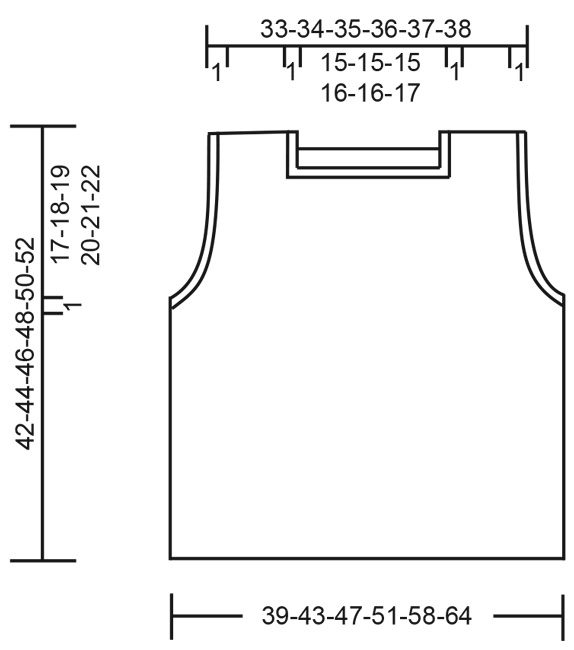
|
|
|
Have you made this or any other of our designs? Tag your pictures in social media with #dropsdesign so we can see them! Do you need help with this pattern?You'll find tutorial videos, a Comments/Questions area and more by visiting the pattern on garnstudio.com. © 1982-2024 DROPS Design A/S. We reserve all rights. This document, including all its sub-sections, has copyrights. Read more about what you can do with our patterns at the bottom of each pattern on our site. |
|








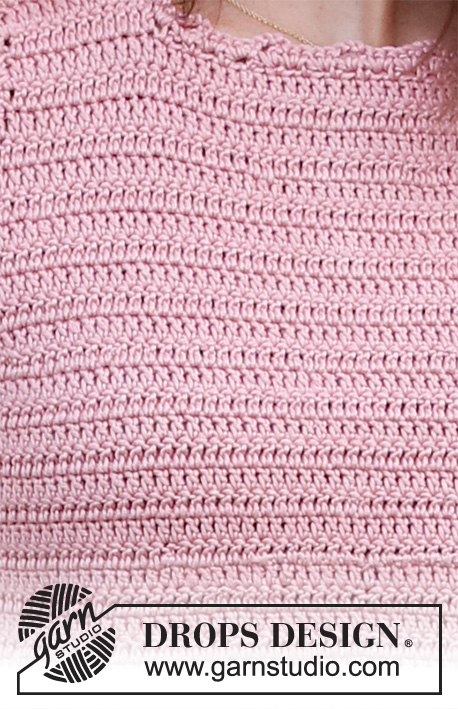



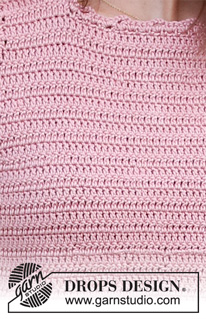




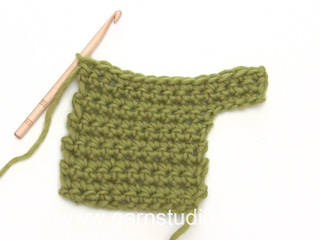
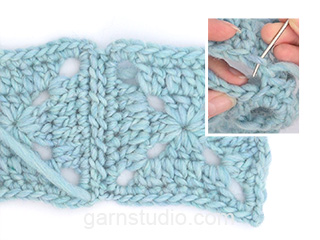


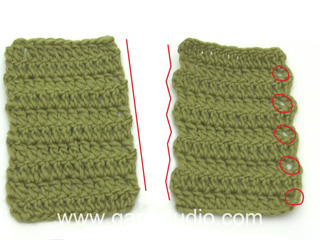




















Comments / Questions (9)
Hi! I am going to crochet this top, I have got the yarn! My question is about sizing: I am a size 12 uk and my bust measurement is 39 inches. Which size do you advise me to make? I have made a crochet top from your website before, I made it a size medium and it was a bit big on me. Would be very grateful for your advice. Thank you.
20.05.2022 - 18:10DROPS Design answered:
Dear Maria Luisa, measure a similar garment you have and like the size and compare these measurements to those in the chart, this is the best way to find the matching size; Read more here. Happy crocheting!
23.05.2022 - 09:06Bij uitleg welke maat haaknaald lijkt het advies net verkeerd om. Heb je teveel steken pak dan grotere naald?
09.05.2022 - 16:32Heyy Heb al vraag gesteld ma ik snap het nog steeds niet. Bij de smal moet je 3 keer in 1 steek gaan enzo maar ik snap niet wat je bedoelt met die 3x in 1steek..? Kunt u het uitleggen aub..?
09.04.2022 - 13:11DROPS Design answered:
Dag Lieze,
Bovenaan bij de uitleg voor het patroon (tip voor het meerderen) staat dit uitgelegd; je meerdert 3 steken aan door 3 lossen aan het eind van de toer te haken en op de volgende toer haak je 1 stokje in elk van de nieuwe lossen.
14.04.2022 - 11:30Hallo, ik heb een vraagje. bij de linkerschouder te haken( heb het al aan het rechter schouder gehaakt) daaronder staat er ergens bij TIP VOOR HET MEERDEREN: meerder 3-2-1-1-1 keer in 1 steek, 0-1-2-3-3-4 keer in 3 steken en dan nog iets gelijkaardigs... ik snap hierbij niet wat je moet doen? kunt u me helpen? ( heb trouwens de versie voor de M. mvg
06.04.2022 - 22:01DROPS Design answered:
Dag Lieze,
De serie getallen refereert aan de verschillende maten, dus als je bijvoorbeeld mat S haakt, neem je het eerste getal. Je meerdert dan dus 3 keer 1 steek en nog eens 0 keer 3 steken en tot slot 1 keer 5 steken.
09.04.2022 - 10:04Hejsa! Jeg forsøger at hækle denne top i str. S, og ser på forstykket at jeg skal lave udtagninger og gå fra 62 masker til 78. Men 1 maske 3 gange og 5 masker en gang giver kun 70 masker, og stykket bliver helt skævt i den ene side hvor der er hæklet 5 nye masker. Er der noget jeg har misforstået?
07.09.2021 - 16:14DROPS Design answered:
Hej Sofie. Du ska ta ut masker i hver side, så du tar ut 8 m på hver side. 62+8+8=78 m. Mvh DROPS Design
08.09.2021 - 08:08Skal der laves 3 lm både i starten og slutningen af rækken, for at kunne hækle kanten pæn hele vejen rundt?
03.09.2021 - 21:40DROPS Design answered:
Hei Louise. Du hekler 3 luftmasker på begynnelsen av hver rad, - les Hekleinformasjon i oppskriften. Disse 3 luftmaskene erstatter IKKE første stav, men du kommer opp i "høyden" med stavene som skal hekles på raden. Du avslutter hver rad med 1 stav. Snu og start med 3 luftmasker. mvh DROPS design
13.09.2021 - 11:26Bij het meerderen van 1 steek bij de armsgaten moet je 1 losse haken. Moet je dan ook 3 keerlossen erbij haken? Dus 4 lossen haken in totaal? Groetjes
14.08.2021 - 13:59DROPS Design answered:
Dag Krista,
Ja, je haakt inderdaad gewoon 3 keerlossen zoals anders, daarna haak je een stokje in de nieuwe losse, dit is de meerdering. Vervolgens haak je verder over de toer.
17.08.2021 - 12:38Hvad er maskesting til at sy toppen sammen med. Kan kun finde maskesting til strik
28.07.2021 - 12:56DROPS Design answered:
Hej Mette, Se den video "Sy hæklede ruder sammen" så får du en fin søm :)
04.08.2021 - 08:44C est une petit top d 'été comme on les adore de chez drop.
07.04.2021 - 08:15